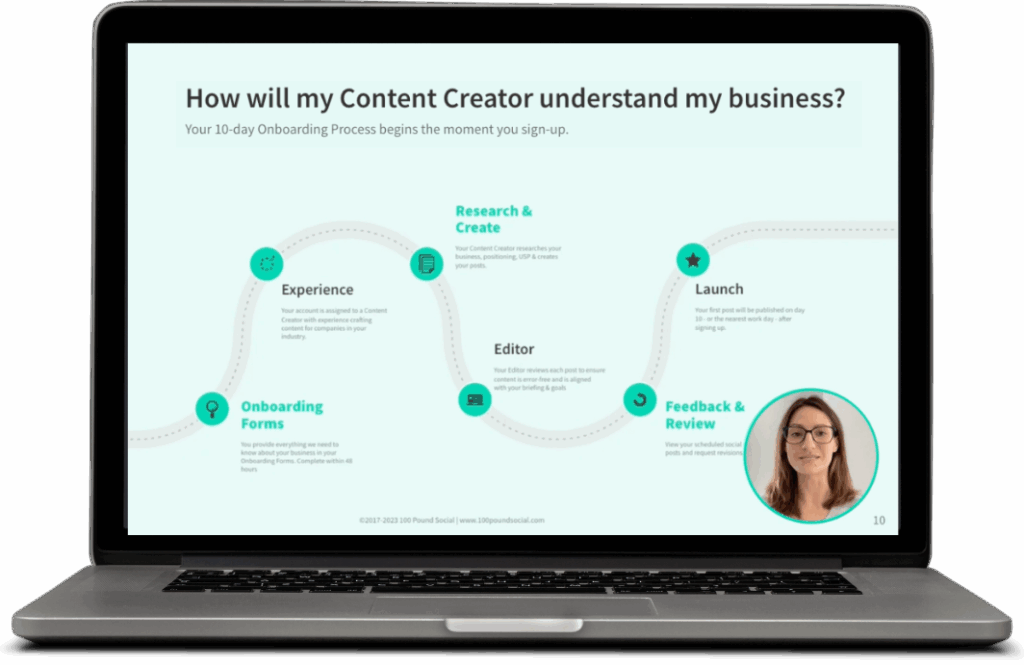When you scroll through your social media feed, some businesses just seem to “click” with you.
Their posts feel genuine, their stories resonate, and their comments make you nod in agreement. What you’re connecting with is their brand voice – the personality behind their words.
Your brand voice defines how your business communicates online. The consistent character and style shine through your captions, comments, stories, and responses. Think of it as your business’s personality expressed through words.
A strong social media brand voice doesn’t happen by accident.
It’s carefully created to build trust, boost engagement, and establish credibility. When done right, it turns casual followers into loyal clients.
This guide explains why your voice matters on social media platforms and how to develop one that feels authentic to your business values while appealing to your ideal clients. With practical brand voice examples and clear steps, you’ll learn how to create a social media brand voice that makes your business stand out.
What is a Brand Voice?
Think of your brand voice as your business’s personality in written form. It’s how your company expresses itself through words, whether in social media posts, emails, or website copy.
Just as you might describe a person as “cheerful and straightforward” or “thoughtful and precise,” your brand voice characterises your communication.
Your brand voice is your business’s unique personality and communication style. It reflects your company values, resonates with your target audience, and sets you apart from competitors. A strong brand voice answers, “If my brand was a person, how would they speak?”
Unlike tone, which may shift depending on the situation, your brand voice remains consistent across all platforms and touchpoints.
Your tone might be celebratory in a post about hitting a milestone but sympathetic when addressing client concerns. However, your underlying voice – playful, authoritative, or compassionate – stays the same throughout.
This consistency is crucial.
Clients who encounter your content on different platforms should immediately recognise it as yours, even without seeing your logo.
Sprout Social reports that 76% of consumers are more likely to buy from a brand they recognise than a competitor, and more than half (57%) will increase their spending.
A well-built brand voice helps clients connect with your business on a deeper level. It transforms your company from a faceless entity into something with character and purpose that people can relate to.
Bonus: Download our FREE Brand Messaging Guide here →
Why Your Brand Voice Matters on Social Media
Social media isn’t just a broadcast channel – it’s a conversation space where your business interacts directly with clients.
Having a clear, consistent brand voice isn’t optional; it’s essential for making these interactions count. Here’s why your brand voice matters so much on social platforms:
Build Trust & Credibility
A clear, authentic voice reassures potential clients that real humans are behind your business. Clients who recognise your distinct way of communicating develop a sense of familiarity with your brand. This familiarity breeds trust.
Small businesses, in particular, benefit from a genuine brand voice, especially since 28% of UK consumers are more likely to trust a friend’s recommendation than anyone else’s.
Increase Engagement
Content with personality gets noticed. Posts that sound like they came from a real person attract more likes, comments, and shares.
A distinctive voice makes your content more engaging by infusing it with character. Whether you’re informative, witty, compassionate, or bold, a strong voice keeps followers interested in what you’ll say next. This interest translates into higher engagement rates, which social media algorithms reward with greater reach.
Notice how some brands consistently receive more comments than others in your industry? Their brand voice likely plays a significant role in starting those conversations.
Stand Out From Competitors
In crowded markets, a well-defined voice helps differentiate your business. When several companies offer similar products or services, the way you communicate can become your competitive advantage.
Think about popular consumer brands that have mastered this distinction. You can recognise their social posts without even seeing their names. That sort of recognition is what you want for your business.
Your unique voice cuts through the noise of identical-looking posts and forgettable messaging. It answers the question: “Why should someone follow us instead of our competitors?”
Strengthen Connections
Personal, relatable content fosters loyalty beyond the transaction. Your social media presence consistently reflects your brand’s values and personality, creating an emotional connection with your audience.
This connection matters because emotionally engaged clients are more valuable.
Your brand voice shapes how people feel about your business. When followers connect with your personality, they’re more likely to become loyal clients who choose your business repeatedly – not because you’re always the cheapest option but because they feel aligned with who you are.
In social media spaces where attention is scarce and competition is fierce, your brand voice becomes a powerful tool for creating meaningful relationships that translate into business growth.
How to Define Your Brand Voice
Finding your brand voice isn’t about inventing a new personality from scratch. It’s about articulating who you already are consistently and strategically. Here’s a practical process to help you define a voice that feels authentic to your business and appealing to your audience.
Identify Core Values – What Does Your Business Stand For?
Your brand voice should naturally reflect your business’s fundamental values and mission. Start by answering these questions:
- What principles guide your business decisions?
- What motivated you to start this business?
- What makes you proud about the work you do?
- What client problems are you most passionate about solving?
For example, if one of your core values is “making complex things simple,” your brand voice might be clear, patient, and jargon-free. If “challenging the status quo” is central to your mission, your voice might be bold and thought-provoking.
Your values provide the foundation for your voice. When your communication style aligns with these values, your messaging feels genuine rather than forced.
Know Your Audience – Who Are You Speaking To?
Your brand voice needs to connect with the people you want to reach. Research your ideal clients to understand:
- What communication styles they respond to
- What tone they use when discussing topics in your industry
- What content formats they prefer
- Which other brands they follow and engage with
This research can include studying social media analytics, conducting client interviews, or reviewing comments on your existing content.
Remember that your voice should feel authentic to your brand while still appealing to your audience. If you try to sound too much like your audience (using slang that doesn’t fit your brand, for instance), you risk coming across as inauthentic.
Choose 3-5 Voice Traits – What’s Your Personality?
Now, identify specific characteristics that will define your brand’s personality. Limit yourself to 3-5 key traits to maintain focus and consistency.
For each trait, create a simple chart that shows:
- What this trait means for your brand
- What this trait doesn’t mean
- Examples of how this appears in your content
For instance:
Trait: Friendly
- Does mean: Warm, conversational, approachable
- Doesn’t mean: Overly casual, unprofessional, using slang inappropriately
- Example: “Thanks for reaching out! We’d love to help with your project.”
Trait: Authoritative
- Does mean: Confident, knowledgeable, backed by expertise
- Doesn’t mean: Condescending, rigid, using unnecessary jargon
- Example: “Our research shows this approach increases conversions by 28%.”
These traits should work together harmoniously. If “professional” and “playful” are both on your list, you’ll need to define clearly how these traits coexist without creating a confusing impression.
Create Brand Voice Guidelines – Document Do’s and Don’ts
Turn your defined traits into practical guidelines your team can follow. Your brand voice documentation should include:
- Your 3-5 key voice traits with clear definitions
- Examples of how each trait sounds in actual content
- Specific language preferences (words to use or avoid)
- Grammar and style choices that support your voice
- Examples of your voice applied to different content types (posts, comments, etc.)
These guidelines ensure that everyone creating content for your social media accounts understands how to maintain a consistent voice, even when multiple people are involved.
Keep your guidelines accessible to anyone who writes for your brand, and review them periodically to ensure they align with your business goals and audience expectations.
Join a Demo and See How 100 Pound Social Can Boost Your Business →
Brand Voice Examples in Action
Understanding brand voice concepts is one thing, but seeing them applied in real-world scenarios makes the ideas click. Let’s examine how different brand voices play out across social media content and why they work for particular businesses.
Professional & Authoritative
Consider a management consulting firm with this social media update:
“We help B2B companies streamline operations and drive long-term growth. Our latest case study shows how we helped Company X reduce operational costs by 32% while increasing productivity.
This voice works because it communicates expertise without being stuffy. The firm uses specific numbers to support its claims, focusing on results and benefits. They maintain a confident tone that reassures potential clients without appearing arrogant.
This brand voice suits businesses where trust is built on demonstrated expertise and proven results. This approach benefits financial services, legal firms, and B2B companies. Notice how the language is clear and direct without being cold – it’s professional without sacrificing human connection.
For example, when McKinsey & Company posts on LinkedIn, you’ll see this professional authority in action.
Their voice establishes credibility through specific insights and data while avoiding unnecessary jargon that might alienate their audience.
Friendly & Informal
Now, imagine a marketing agency posting this update:
“We turn boring content into engaging posts – without the stress! Just handed over this month’s content calendar to a client who called it ‘exactly what we needed but couldn’t create ourselves.’ This is why we love Mondays!
This voice succeeds because it shows personality and enthusiasm. The agency uses conversational language that makes it feel like a friend is talking. They incorporate client feedback naturally into their post and create an emotional connection through shared experiences.
Reading their content feels like chatting with someone who understands your challenges but doesn’t take themselves too seriously.
This approach works well for businesses where being approachable matters more than formality. Creative agencies, small retail businesses, and community-focused brands often use this voice to build relationships that feel personal rather than transactional.
You can see this style when Innocent Drinks posts on social media.
Their casual, sometimes playful voice makes their brand feel friendly and human, perfectly matching their product positioning.
Approachable & Reassuring
Finally, here’s how an accounting firm might craft its message:
“We simplify accounting so you can focus on running your business. Our clients tell us the biggest relief isn’t just getting their taxes filed correctly – it’s finally understanding their finances and feeling confident about their decisions.”
This voice is effective because it acknowledges client pain points directly. The firm offers reassurance without patronising and balances professional competence with genuine approachability. They focus on emotional benefits alongside practical ones, recognising that peace of mind is just as important as technical accuracy for their clients.
This blend of professional knowledge and emotional understanding works well for businesses that help clients navigate complex or stressful situations. Healthcare providers, financial advisors, and educational services often adopt this voice to build trust while reducing anxiety.
When browsing through content from companies like BDO, you’ll notice how they make it about the client: “Helping you tackle the pressing issues your business is facing.”
Key Takeaways
Your social media presence isn’t just about what you say – it’s about how you say it. This guide shows how your brand voice is the foundation for meaningful connections with your audience.
You build trust naturally when you consistently communicate in a voice that aligns with your values and resonates with your audience. People begin to recognise your content even before they see your name. This recognition creates familiarity, making your business feel more reliable and professional.
Your distinct voice also makes your content more engaging. When followers can sense the personality behind your posts, they’re more likely to stop scrolling and interact with what you’ve shared. These interactions signal algorithms that your content is valuable, expanding your reach and impact.
Perhaps most importantly, your brand voice helps you stand out in crowded markets. When clients have many similar options, how you communicate can become your competitive edge. Your voice transforms your business from just another option into a brand people feel connected to on a personal level.
Remember that finding your brand voice isn’t a one-time exercise. Your voice may need subtle refinements as your business grows and your audience evolves. The most successful brands regularly revisit their voice guidelines to ensure they remain authentic and effective.
Next Steps
Creating and maintaining a consistent brand voice across social media platforms can be challenging when you’re already busy running your business.
100 Pound Social can help. Our expert UK-based team specialises in developing authentic brand voices that connect with your target audience and generate actual business results.
As a result of working with us, our clients report increased engagement rates, more substantial brand recognition, and most importantly, more conversions from their social media presence.
Looking for a complete solution?
Our £100 Posts Plan includes three professionally crafted social media posts per week that consistently reflect your brand voice across LinkedIn, Facebook, X, Instagram, and Google Business Profile.
Book a call today, or join a free 15-minute demo.







